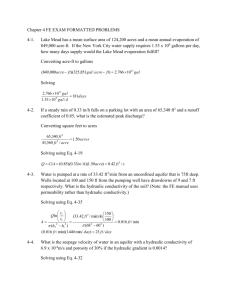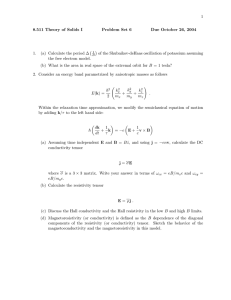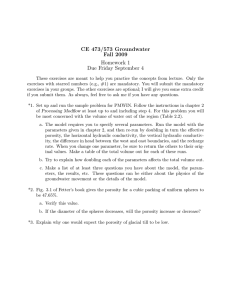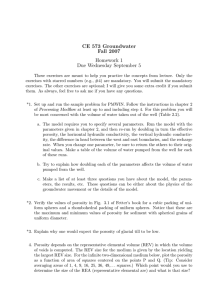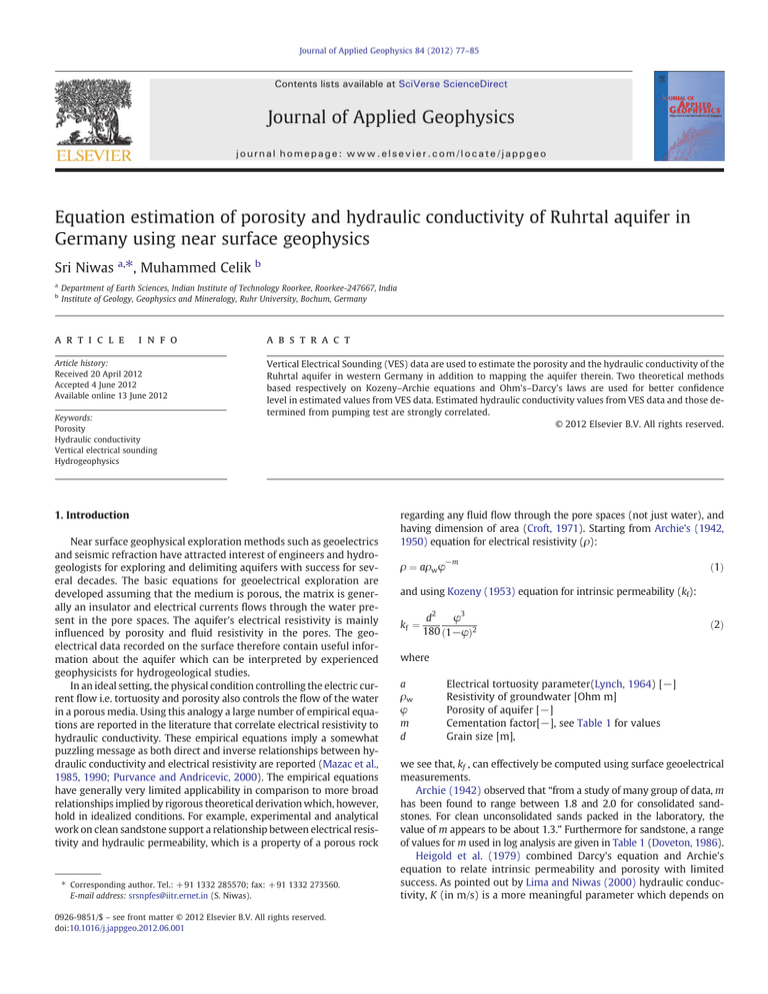
Journal of Applied Geophysics 84 (2012) 77–85
Contents lists available at SciVerse ScienceDirect
Journal of Applied Geophysics
journal homepage: www.elsevier.com/locate/jappgeo
Equation estimation of porosity and hydraulic conductivity of Ruhrtal aquifer in
Germany using near surface geophysics
Sri Niwas a,⁎, Muhammed Celik b
a
b
Department of Earth Sciences, Indian Institute of Technology Roorkee, Roorkee-247667, India
Institute of Geology, Geophysics and Mineralogy, Ruhr University, Bochum, Germany
a r t i c l e
i n f o
Article history:
Received 20 April 2012
Accepted 4 June 2012
Available online 13 June 2012
Keywords:
Porosity
Hydraulic conductivity
Vertical electrical sounding
Hydrogeophysics
a b s t r a c t
Vertical Electrical Sounding (VES) data are used to estimate the porosity and the hydraulic conductivity of the
Ruhrtal aquifer in western Germany in addition to mapping the aquifer therein. Two theoretical methods
based respectively on Kozeny–Archie equations and Ohm's–Darcy's laws are used for better confidence
level in estimated values from VES data. Estimated hydraulic conductivity values from VES data and those determined from pumping test are strongly correlated.
© 2012 Elsevier B.V. All rights reserved.
1. Introduction
Near surface geophysical exploration methods such as geoelectrics
and seismic refraction have attracted interest of engineers and hydrogeologists for exploring and delimiting aquifers with success for several decades. The basic equations for geoelectrical exploration are
developed assuming that the medium is porous, the matrix is generally an insulator and electrical currents flows through the water present in the pore spaces. The aquifer's electrical resistivity is mainly
influenced by porosity and fluid resistivity in the pores. The geoelectrical data recorded on the surface therefore contain useful information about the aquifer which can be interpreted by experienced
geophysicists for hydrogeological studies.
In an ideal setting, the physical condition controlling the electric current flow i.e. tortuosity and porosity also controls the flow of the water
in a porous media. Using this analogy a large number of empirical equations are reported in the literature that correlate electrical resistivity to
hydraulic conductivity. These empirical equations imply a somewhat
puzzling message as both direct and inverse relationships between hydraulic conductivity and electrical resistivity are reported (Mazac et al.,
1985, 1990; Purvance and Andricevic, 2000). The empirical equations
have generally very limited applicability in comparison to more broad
relationships implied by rigorous theoretical derivation which, however,
hold in idealized conditions. For example, experimental and analytical
work on clean sandstone support a relationship between electrical resistivity and hydraulic permeability, which is a property of a porous rock
⁎ Corresponding author. Tel.: + 91 1332 285570; fax: + 91 1332 273560.
E-mail address: srsnpfes@iitr.ernet.in (S. Niwas).
0926-9851/$ – see front matter © 2012 Elsevier B.V. All rights reserved.
doi:10.1016/j.jappgeo.2012.06.001
regarding any fluid flow through the pore spaces (not just water), and
having dimension of area (Croft, 1971). Starting from Archie's (1942,
1950) equation for electrical resistivity (ρ):
−m
ρ ¼ aρw φ
ð1Þ
and using Kozeny (1953) equation for intrinsic permeability (kf):
kf ¼
d2
φ3
180 ð1−φÞ2
ð2Þ
where
a
ρw
φ
m
d
Electrical tortuosity parameter(Lynch, 1964) [−]
Resistivity of groundwater [Ohm m]
Porosity of aquifer [−]
Cementation factor[−], see Table 1 for values
Grain size [m],
we see that, kf , can effectively be computed using surface geoelectrical
measurements.
Archie (1942) observed that “from a study of many group of data, m
has been found to range between 1.8 and 2.0 for consolidated sandstones. For clean unconsolidated sands packed in the laboratory, the
value of m appears to be about 1.3.” Furthermore for sandstone, a range
of values for m used in log analysis are given in Table 1 (Doveton, 1986).
Heigold et al. (1979) combined Darcy's equation and Archie's
equation to relate intrinsic permeability and porosity with limited
success. As pointed out by Lima and Niwas (2000) hydraulic conductivity, K (in m/s) is a more meaningful parameter which depends on
78
S. Niwas, M. Celik / Journal of Applied Geophysics 84 (2012) 77–85
basement. For validation of the two methods, hydraulic conductivity
and porosity are acquired through the installation of wells and conducting pumping tests.
Estimated porosity and the hydraulic conductivity from geoelectric
measurements are the desired values attributed at a point and nearby.
This study establishes a correlation between the hydraulic conductivity
values obtained by pumping test and from surface geoelectrical measurements. Additionally, the cross plotting of the geoelectric estimated
hydraulic parameters from Method-I and Method-II enhances the reliability of the results.
Table 1
Values of m (Doveton, 1986).
Formation type
m value [−]
Unconsolidated sand
Very slightly cemented sandstone
Slightly cemented sandstone
Moderately cemented sandstone
Highly cemented sandstone
1.3
1.4–1.5
1.5–1.7
1.8–1.9
2.0–2.2
both the type of formation and the fluid properties contained in it. To
this end Nutting's equation (Hubert, 1940) relates kf to K as,
K¼
δw g
k
μ f
ð3Þ
where
δw
g
μ
Water density [1000 kg/m 3]
Acceleration due to gravity [9.81 m/s 2]
Water dynamic viscosity [0.0014 kg/m s].
Finally, works such as that of Rucker (2009), where fully coupled
resistivity‐flow models are developed, aim to estimate hydraulic
properties by combining the physical phenomena of electrical current
and water flow through porous media. However, the work still requires constitutive relations, such as Archie's equation, to convert
the jointly influencing parameter (i.e. moisture) from one set of physical models to the other. Notwithstanding, the effort should be to obtain a more physically supported quantitative relation instead of an
empirical one.
Using more basic Ohm's law of current flow and Darcy's law for
horizontal fluid flow in a medium Niwas and Singhal (1981, 1985)
derived two analytical equations,
T ¼ αS;
α ¼ Kρ
ð4Þ
β ¼ K=ρ
ð5Þ
and
T ¼ βR
respectively representing inverse and direct relationship between
electrical resistivity and hydraulic conductivity,where
T
R = dρ
S = d/ρ
d [m]
α, β
Hydraulic transmissivity [m 2/s]
Transverse resistance [Ohm]
Longitudinal conductance [S],
thickness of the aquifer;
constant of proportionality.
Analyzing these two equations further, Niwas et al. (2011) successfully solved the contradiction between direct and inverse relationship of
electrical resistivity and hydraulic conductivity. Their analysis included
data from Krauthausen test site in Germany fitted to analytical geoelectrical modeling results. They concluded that Eq. (4) exists in case
of highly resistive basement (S- dominant aquifer where electrical currents tends to flow horizontally) and Eq. (5) exists in case of highly conducting basement (R-dominant aquifer where electrical currents tend
to flow vertically).
In this study, geoelectric data are acquired to estimate the hydraulic conductivity values of the Ruhr aquifer. It is proposed to use
both theoretical approaches discussed above for the estimation of
hydraulic conductivity so that merits and limitations of each method
are highlighted. Method I uses Eqs. (1), (2) and (3) to calculate the
porosity and the hydraulic conductivity from resistivity data whereas Method II uses Eqs. (4) or (5) depending on electrical nature of the
2. Site description
2.1. Study area
The study was carried out in Ruhrtal located south of the Ruhr University in Bochum, Germany. The study area is on the bank of the
south-west portion of Kemnader lake and covers an area of 199016 m 2
(Fig. 1). Our work was conducted just upstream from a hydroelectric
dam. The region was chosen for the hydrophysical study because the
geological and hydrogeological characteristics of the area were known.
For example there were several existing wells along with well logs providing lithological description that were advantageous to the present
study. Additionally for this study, satellite images taken from Google
earth (Google, 2011) were georeferenced in ArcGis to UTM coordinate
system.
2.2. Geology of the study area
During the building of the Kemnader dam the surface had been filled
with backfill (Holocene). The fill, composed of silt and gravel, had a
thickness from 1 m up to 6 m. There was no filling where the river
Ruhr begins to flow. The fill was underlain by a 0.2 m to 3.5 m silt
layer of Holocene age. The Pleistocene aged Niederterrasse formation
consisted of a gravel-sand bed that filled under the silt layer. It was
the aquifer layer with a high hydraulic conductivity and the thickness
of the aquifer ranges from 4 m to 6.5 m. The aquifer layer was underlain
by the faulted bed rock composed of claystone, siltstone and sandstone
beds. The depth of the Carboniferous (Carbon.) aged bedrock ranges
from 6.5 m up to 12.5 m (Hahne and Schmidt, 1982).
2.3. Hydrogeology
Over the past several decades, pumping tests have been performed
in the Ruhrtal aquifer. Table 3 lists the values for six available wells
(W4, W5, W6, W7, W8 and W9). The pumping test on the observation
well W8 was carried out during the field course “Markierungsversuch”
at the Ruhr University Bochum (Stemke et al., 2009). The pumping tests
of the rest of the observation wells were performed by Ruhr University,
Bochum in September 1979 (Obermann and Diegelmann, 1980). We
show the hydraulic conductivity results of the pumping tests using
three different methods: Thiem (stationary), Jacob (non-stationary)
and Jacob recovery (non-stationary). For final analysis of the tests, we
used an average hydraulic conductivity obtained from three methods.
3. Geoelectrical measurements
The aim of the study is to explore the gravel-sand aquifer layer to
estimate the hydraulic parameters from Vertical Electrical Sounding
(VES) measurements. The Schlumberger array was chosen due to its
better lateral resolution. For the present work, we used the ABEM
Terra-meter
SAS
300C with a maximum half-current electrode separation AB=2 of 250 m. Because of the natural boundaries on the
field (trees, fence, way) the maximum separation AB=2 of some
soundings were less than 250 m. However, all spread were sufficient
S. Niwas, M. Celik / Journal of Applied Geophysics 84 (2012) 77–85
Fig. 1. Study area map and location of VES points along with existing wells (UTM coordinate system, 32 N Zone).
Fig. 2. a and b. Interpretation of VES 1 showing correlation between observation well W9 and VES1(soil identification according to DIN 4022).
79
80
S. Niwas, M. Celik / Journal of Applied Geophysics 84 (2012) 77–85
Fig. 3. a and b. Interpretation of VES 12 showing correlation between observations well W7 and VES12 (soil identification according to DIN 4022).
for the designed depth in view of the concept of ‘Depth of Investigation
(DI)’ determined by the position of the current electrodes (A, B) and the
measuring electrodes (M, N) and not by the current penetration or current distribution alone (Roy and Apparao, 1971). Roy and Apparao
(1971) defined DI as that depth at which a thin horizontal layer of
earth contributes the maximum amount to the total measured signal
at the earth surface. Using basic law of physics Roy and Apparao
(1971) mathematically derived ‘ Depth of Investigation Characteristic’
(DIC) as contribution of a thin layer of thickness, dz, buried in a homogeneous earth of resistivity, ρ, at a depth , z, energized by a current of
strength, I, for a four electrode array (AMNB) given by,
DIC ¼
"
#
ρI
8πz
8πz
8πz
8πz
:ð6Þ
dz
−
−
þ
3=2
3=2
3=2
3=2
4π2
AM2 þ 4z2
BM2 þ 4z2
AN2 þ 4z2
BN2 þ 4z2
By taking AM=BN =0.45AB and MN=0.1 AB for Schlumberger configuration and normalizing Eq. (6) by the total response of homogeneous
earth for this particular array given by, ρI/2.475πAB, Eq. (6) is reduced as
Normalized DIC (NDIC) as,
"
#
1
1
NDIC ¼ −
3=2 3=2 :
ð0:45ABÞ2 þ 4z2
ð0:55ABÞ2 þ 4z2
ð7Þ
The maximum of NDIC is computed by Roy and Apparao (1971) as
DI lies at 0.125 AB; AB = 8* DI. However, Kirsch (2006) gave a different estimate as AB ~ 5*DI. Special attention was also paid to the measurements to ensure they were conducted in a straight line. The VES
electrode positions were installed uniformly along the line and measurements were taken near each of the existing wells for correlation.
Altogether 20 VES were recorded and Fig. 1 shows the layout of both
wells and VES points. A number of bad values caused reiteration of
the acquisition process to improve the quality of data.
Fig. 4. Thickness of the gravel/sand layer determined from VES data.
S. Niwas, M. Celik / Journal of Applied Geophysics 84 (2012) 77–85
81
Fig. 5. Combination of saturated gravel/sand layer profile sections determined from VES data.
3.1. Method I
The inverted resistivity data were used to estimate the porosity
from Eq. (1) using literature values of respective parameters for an
Table 2
Estimated porosity and hydraulic conductivity (Method I).
Points
ρw [Ohm m]
ρ [Ohm m]
φ [−]
K [m/s] × 10− 2
Ves
Ves
Ves
Ves
Ves
Ves
Ves
Ves
Ves
Ves
Ves
Ves
Ves
Ves
Ves
Ves
Ves
Ves
Ves
Ves
17
17
16
14
12
11
14
17
29
18
13
10
10
10.5
19
34
27
12
7
9
121
241
155
87
69
157
256
142
104
165
216
105
65
87
235
439
284
118
103
45
0.22
0.13
0.17
0.25
0.26
0.13
0.11
0.20
0.37
0.18
0.12
0.16
0.24
0.20
0.14
0.14
0.16
0.17
0.13
0.29
6.9
1.1
3.0
10.0
13.0
1.1
0.6
4.5
52.0
3.5
0.8
2.4
8.9
4.6
1.6
1.4
2.4
2.9
1.0
19.0
1
2
3
4
5
6
7
8
9
10
11
12
13
14
15
16
17
18
19
20
unconsolidated gravel-sand. Unconsolidated sediments are characterized by relatively low values of m (between 1.1 and 1.3) and parameter a ≈ 1 (Keller, 1989; Schön, 2004), and we chose to use
a = 1 and m = 1.3. The exponent m correlates with the sphericity P
of the sediment grains and follows an equation, m = 2.9–1.8P
(Atkins and Smith, 1961; Jackson et al., 1978; Schön, 2004). The computed porosity was used to estimate the hydraulic conductivity of the
aquifer layer using Eqs. (2) and (3). Average grain size used in Eq. (2)
was the d50 value which was obtained through sieve analysis. For the
analysis, two soil samples from the Niederterrase formation were
taken at different depth (6.7–7 m and 2.5–2.8 m). The average grain
size value was estimated as 0.01 m in the laboratory (Obermann
and Diegelmann, 1980).
Table 2 shows the results of the calculated porosity and hydraulic
conductivity of the aquifer layer through Method-I. The groundwater
resistivity map was made by interpolating between the groundwater
resistivity values of observation well as measured by Stemke (2010).
The groundwater resistivity at VES points was determined using the
interpolated groundwater resistivity (ρw) map. Accordingly the VES
9 results in Table 2 be shown in red rectangle. The fitting error of
this point has a low value but the average grain size of 0.01 m is
unrealistically large for this point. Therefore VES 9 is excluded
from the interpretation and estimation process. The relationship
between water resistivity and interpreted aquifer resistivity is shown
Aquifer resistivity (Ohm m)
The computer interpretation software “IPI2win” was used for data
inversion. Figs. 2 and 3 show examples of output from the software, including a graphical display of data, estimated geoelectrical properties,
and calculated fitting error between modeled and measured data. The
VES lines were near wells W9 and W7 and Figs. 2b and 3b show the
comparison between the litho-logs and geoelectrical parameters. For
the inversion, we took care to constrain the inversion to the well data
to help with the correlation. Finally, we took all of the georeferenced resistivity values and rendered a three-dimensional depiction of the hydrogeology. Fig. 4 shows the location of the aquifer and water table
relative to the Niederterrasse formation. Fig. 5 shows slices through
the domain to highlight all geological layers.
1000
Observed data
Formation
factor = 11
100
10
1
10
Water resistivity (Ohm m)
Fig. 6. Validation of Archie equation in the study area.
100
82
S. Niwas, M. Celik / Journal of Applied Geophysics 84 (2012) 77–85
Fig. 7. Porosity map of the aquifer layer from resistivity data.
in Fig. 6. We calculated average Percent Error (PE) using a general
formula as,
ffiffiffiffiffiffiffiffiffiffiffiffiffiffiffiffiffiffiffiffiffiffiffiffiffiffiffiffiffiffiffiffiffiffiffiffiffiffiffiffiffiffiffiffiffi1
0 v
u N uX Obs −Comp 2
1
i
i
@ t
A 100;
N i¼1
Obsi
where Obsi is the observed data at ith observation point, Compi is the
equation computed value of the same data at the same point and
being N the number of observation points. Based on the reasonable PE value (≈ 10.5%), the methodology qualifies for porosity estimation because the resistivity is a product of electrical current
flow through the pore space and not along the grain surface.
Fig. 6 also shows the formation factor, calculated by the ratio of
Fig. 8. The hydraulic conductivity map of Ruhrtal aquifer.
S. Niwas, M. Celik / Journal of Applied Geophysics 84 (2012) 77–85
83
Table 3
Results of pumping test of each observation well and the hydraulic conductivity from resistivity data (all values in × 10− 2).
Well
Stationary
(Thiem)
[m/s] × 10− 2
non-stationary
(Jacob)
[m/s] × 10− 2
non-stationary
(Wiederanstieg-Jacob)
[m/s] × 10− 2
Average,
[m/s] × 10− 2
From
Method-I
[m/s] × 10− 2
W4
W5
W6
W7
W8
W9
2.4
1.4
3.5
1.3
2.8
1.5
1.9
1.3
2.5
1.5
2.2
–
1.9
2.1
1.8
2.2
1.9
2.9
–
–
–
1.83
2.03
2.30
2.13
2.80
1.85
–
1.44
2.91
3.40
2.45
2.60
3.30
–
bulk resistivity, ρ, and water resistivity, ρw, the results imply a clean
formation.
Fig. 7 shows the porosity map of Kemnader area using the geoelectrical data. It should be clarified that the minimum and maximum
porosity values, calculated from the VES analysis, are likely due to the
basic principles of averaging and are not the result of any spatial interpolations algorithms or measurement error. In the Schlumberger
array, the potential differences are measured between MN electrodes
and the apparent resistivity is calculated from these potential differences. By convention, the calculated apparent resistivity is attributed
to the middle point of MN electrodes, but the ‘depth of investigation’
is determined by relation between AB and DI as demonstrated in
Eq. (7) (Kirsch, 2006; Roy and Apparao, 1971). The larger the AB electrode spacing, the deeper is the sounding. Based on the information
from the depth sounding, both resistivity and layer thickness are determined. However, the resistivity value of each layer is an average
value, constructed from all of the smaller scaled heterogeneities within that layer. Thus, the calculated porosity value of an aquifer, using
an average resistivity, results in an averaged porosity value. Therefore
it is possible to measure, for example on VES 5 a porosity of 0.26 and
~50 m away on VES 6 porosity of 0.14 because the volume over which
averaging occurs for each VES point is different.
The hydraulic conductivity was computed through Eqs. (2) and (3)
and the final values are provided in Table 2. Fig. 8 shows the hydraulic
conductivity map of the study area. In general, the Ruhrtal aquifer in
the study area has a high hydraulic conductivity value, but the northern
part of the area has a lower hydraulic conductivity than the southern
part. When the hydraulic conductivity data from Method I is compared
to that obtained from pumping tests (Table 3), we observed a worthy
comparison between the independently derived data sets (Fig. 9). In
particular, the comparison on well W4 and W7 between the average
value of pumping test result and the hydraulic conductivity value from
the resistivity data is quite good (overall average PE between estimated
values and average pump test values ≈ 15%). There is a significant comparison (average PE≈ 8%) between the values using the non-stationary
method and the estimated hydraulic conductivity from resistivity data.
For this analysis using Method I, we excluded well W9 due to low confidence in data. The reason of the bad correlation between the pumping
test result and VES measurements on W9 were likely due to the
wrong measured average groundwater resistivity on W9 and the strong
variation of the hydraulic conductivity from VES point near the well because of heterogeneity.
Table 4
Results of the calculated hydraulic parameters (Method II).
K_obs [m/
s] × 10− 2
S = d/ρ,
[mho]
K_com [m/
s] × 10− 2
T = 4 S, [m2/
s] × 10− 2
Ves 1
Ves 2
Ves 3
Ves 4
Ves 5
Ves 6
Ves 7
Ves 8
Ves 9
Ves
10
Ves
11
Ves
12
Ves
13
Ves
14
Ves
15
Ves
16
Ves
17
Ves
18
Ves
19
Ves
20
121
241
155
87
69
157
256
142
104
165
1.85
–
2.80
–
–
–
–
–
–
–
0.037
0.027
0.024
0.091
0.066
0.039
0.031
0.070
0.087
0.053
3.3
1.7
2.6
4.6
5.8
2.5
1.6
2.8
3.8
2.4
14.9
10.9
9.5
36.3
26.5
15.6
12.3
28.2
35.0
22.1
5.45 –
216
–
0.025
1.9
10.1
5.56 W7
105
2.13
0.053
2.5
21.2
6.74 –
65
–
0.100
6.1
41.5
–
87
–
0.130
4.6
52.1
5.43 –
235
–
0.023
1.7
9.2
4.49 W4
439
1.83
0.010
1.4
4.1
284
–
0.036
1.4
14.4
5.87 W5
118
2.03
0.050
2.9
19.9
4.71 W6
103
2.30
0.046
3.4
18.3
3.20 –
45
–
0.071
8.9
28.4
4.50
6.54
3.67
7.90
4.58
6.12
7.9
10.0
9.11
9.10
11.3
10.2
W9
–
W8
–
–
–
–
–
–
–
–
3.2. Method II
One of the essential requirements of Method II for estimating hydraulic parameter from surface geoelectrical measurement is that the
hydraulic conductivity from at least one or more points in the area
must be known before hand. The hydraulic conductivity is used to ascertain the value of constant of proportionality. Table 3 provides the
hydraulic conductivity values based on pumping test at 6 points giving an average value of α = 4 for Eq. (4), as the electrical nature of
bedrock is resistive in comparison to aquifer. Table 4 gives the relevant hydraulic parameters computed for Method II, with K = 4/ρ
and T = 4 S.
Hydraulic conductivity (m/s)pump test
Points d [m] Well ρ
[Ohm
m]
0.1
0.01
Average (PE=15%)
Non-stationary(PE=8%)
Ideal (PE= 0 %)
0.001
0.001
0.01
0.1
Hydraulic conductivity (m/s)-l
Fig. 9. Cross-plot between estimated hydraulic conductivity from resistivity data through
Method I and that obtained from pump test.
84
S. Niwas, M. Celik / Journal of Applied Geophysics 84 (2012) 77–85
K values
Hydraulic conductivity (m/s)
1.00E+00
K = 5/Rho
1.00E-01
1.00E-02
1.00E-03
10
100
1000
Aquifer resisitivity (Ohm m)
Fig. 10. Inverse relationship between aquifer resistivity and hydraulic conductivity for
Ruhrtal aquifer.
3.3. Comparison between Method I and Method II
The estimated hydraulic conductivity from Method I was compared to that from Method II in order to provide an independent verification of the hydraulic properties between the two methods. First
the calculated hydraulic conductivity was plotted as a function of
aquifer resistivity and the results are presented in Fig. 10. There is
an inverse relationship between the two, which aligned with the development of theoretical equations for a resistive basement (Niwas et al.,
2011). From these data, we obtained the average value of α = 5 (average
PE≈ 11%) while taking into account the 19 valid estimated hydraulic
conductivity values. Finally, the two sets of values for hydraulic conductivity using Method I and Method II were cross plotted to observe the relationship between them. Fig. 11 shows the cross plot (actual and ideal)
with satisfactory result (average PE≈ 20%) keeping in mind the heterogeneous nature of formations in the area.
4. Discussion and conclusion
Hydraulic conductivity (m/s)-ll
On the basis of the results of the estimated porosity with minimum of
11% and maximum 29% and the estimated hydraulic conductivity with
minimum 7.6 ×10− 3 m/s and maximum 1.9 ×10− 1 m/s (in comparison
to pump test determined range of 10− 2 m/s) from 20 resistivity points
given in Table 2, a realistic porosity-hydraulic conductivity model for
Ruhrtal aquifer is obtained that strengthens the validity of determining
the hydraulic parameters by using surface geophysical measurements.
A realistic model is possible on the basis of reliable values of water resistivity and low mathematical fitting error of each VES measurements. The
observed data show an expected structure of the correlation between
1
Cross Plot(Actual)
Cross Plot (Ideal)
0.1
0.01
0.001
0.001
0.01
0.1
1
Hydraulic conductivity (m/s)-l
Fig. 11. Cross plot between estimated hydraulic conductivity from resistivity data using
Method I and Method II.
hydraulic conductivity and porosity. The presence of the groundwater
decreases the resistivity of the layer if the background resistivity (unsaturated soil) of the layer is higher than in a saturated situation. Therefore
the increasing resistivity for the same material means that the porosity,
which is also saturated, decreases. Eventually the increase in resistivity
lowers the hydraulic conductivity (Fig. 10).
The theoretical Method I and Method II, of hydraulic conductivity
estimation from surface geoelectrical measurements are strongly
correlated with themselves and with the available pump test values.
As mentioned earlier Method I combines Archie (1942) and Kozeny
(1953) through porosity. Thus the success of the method largely depends on porosity estimation using Archie's equation. However, this
equation can only effectively be used in case of the formation having
no appreciable amount of clay and the values for water resistivity are
available from other sources. On the other hand Method II combines
more basic laws of Darcy and Ohm through the cross sectional area
perpendicular to the flow direction. In this case the hydraulic conductivity at one or more points of VES location and the electrical nature (conducting or resistive) of the bedrock must be available.
Method II may be used even when the aquifer material is clayey. In
the present area necessary conditions for both the methods are
satisfied.
Acknowledgements
We are thankful to Prof. Stefan Wohnich, Chair Professor of Geology
of Ruhr University for providing all help in conducting fieldwork and
completion of the project. We are highly indebted to two reviewers,
Dr. Dale Rucker and one anonymous, for their constructive review that
has highly improved the presentation of the paper.
References
Archie, G., 1942. The electrical resistivity log as an aid in determining some reservoir
characteristics. Petroleum Transactions of the American Institute of Mineralogical
and Metallurgical Engineers 146, 54–62.
Archie, G., 1950. Introduction to petrophysics of reservoir rocks. AAPG Bulletin 34,
943–961.
Atkins, E.R., Smith, G.H., 1961. The significance of particle shape in formation resistivity
factor porosity relationships. Journal of Petroleum Technology 13, 285–291.
Croft, M.G., 1971. Method of calculating permeability from electric log. U.S. Geological
Survey Professional Paper 750, 265–269.
Doveton, J.H., 1986. Log Analysis of Subsurface Geology. Wiley, New York.
Google, 2011. Google EarthRetrieved from , http://www.google.com/earth 2011.
Hahne, C., Schmidt, R., 1982. Die Geologie des Niederrheinisch-Westfälischen
Steinkohlengebietes. Verlag Glückauf.
Heigold, P.C., Gilkeson, R.H., Cartwright, K., Reed, P.C., 1979. Aquifer transmissivity
from surficial electrical methods. Groundwater 17, 330–345.
Hubert, M.K., 1940. The theory of groundwater motions. Journal of Geology 48, 785–944.
Jackson, P.D., Taylor, D., Smith, P.M., 1978. Standard resistivity–porosity–particle shape
relationships for marine sands. Geophysics 43, 1250–1268.
Keller, G.V., 1989. Electrical properties. In: Carmichael, R.S. (Ed.), Practical Handbook of
Physical Properties of Rocks and Minerals. CRC Press, Boca Raton.
Kirsch, R., 2006. Groundwater Geophysics: A Tool for Hydrogeology. Springer
3540293833.
Kozeny, J., 1953. Hydraulics. Springer, Vienna.
Lima, O.A.L., Niwas, Sri, 2000. Estimation of hydraulic parameters of shaly sandstone
aquifers from geoelectrical measurements. Journal of Hydrology 235, 12–26.
Lynch, E.J., 1964. Formation Evaluation. Harper and Row Publishers Inc., New York.
Mazac, O., Kelly, W.E., Landa, I., 1985. A hydrogeophysical model for relation
between electrical and hydraulic properties of aquifers. Journal of Hydrology
79, 1–19.
Mazac, O., Kelly, W.E., Landa, I., Venhodova, D., 1990. Determination of hydraulic
conductivities by surface geoelectrical methods. In: Ward, S.H. (Ed.), Geoelectrical and environmental geophysics: Environmental and groundwater applications, v. 2, pp. 125–131.
Niwas, Sri, Singhal, D.C., 1981. Estimation of aquifer transmissivity from Dar-Zarrouk
parameters in porous media. Journal of Hydrology 50, 393–399.
Niwas, Sri, Singhal, D.C., 1985. Aquifer transmissivity of porous media from resistivity
data. Journal of Hydrology 82, 143–153.
Niwas, Sri, Tezkan, B., Israil, M., 2011. Aquifer hydraulic conductivity estimation from
surface geoelectrical measurements for Krauthausen test site, Germany. Hydrogeology Journal 19, 307–315.
Obermann, P., Diegelmann, B., 1980. Hydrogeologische Untersuchung am Kemnader
See. Ruhr Universität Bochum, Bochum.
S. Niwas, M. Celik / Journal of Applied Geophysics 84 (2012) 77–85
Purvance, D.T., Andricevic, R., 2000. On the electric-hydraulic conductivity correlation
in aquifers. Water Resources Research 36, 2905–2913.
Roy, A., Apparao, A., 1971. Depth of investigation in direct current methods. Geophysics
36, 943–959.
Rucker, D.F., 2009. A coupled electrical resistivity-infiltration model for wetting front
evaluation. Vadose Zone Journal 8, 383–388.
Schön, J.H., 2004. Physical Properties of Rocks. Elsevier, Amsterdam.
85
Stemke, M., 2010. Labor und Feldversuche zur Desorptionscharakteristik von
Fluoreszenzfarbstoffen im Talgrundwasserleiter der Ruhr. Ruhr University, Bochum,
Germany.
Stemke, M., Wiesner, B., Celik, M., 2009. Auswertung des Markierungsversuches am
Kemnader See. Ruhr University, Bochum, Germany.

